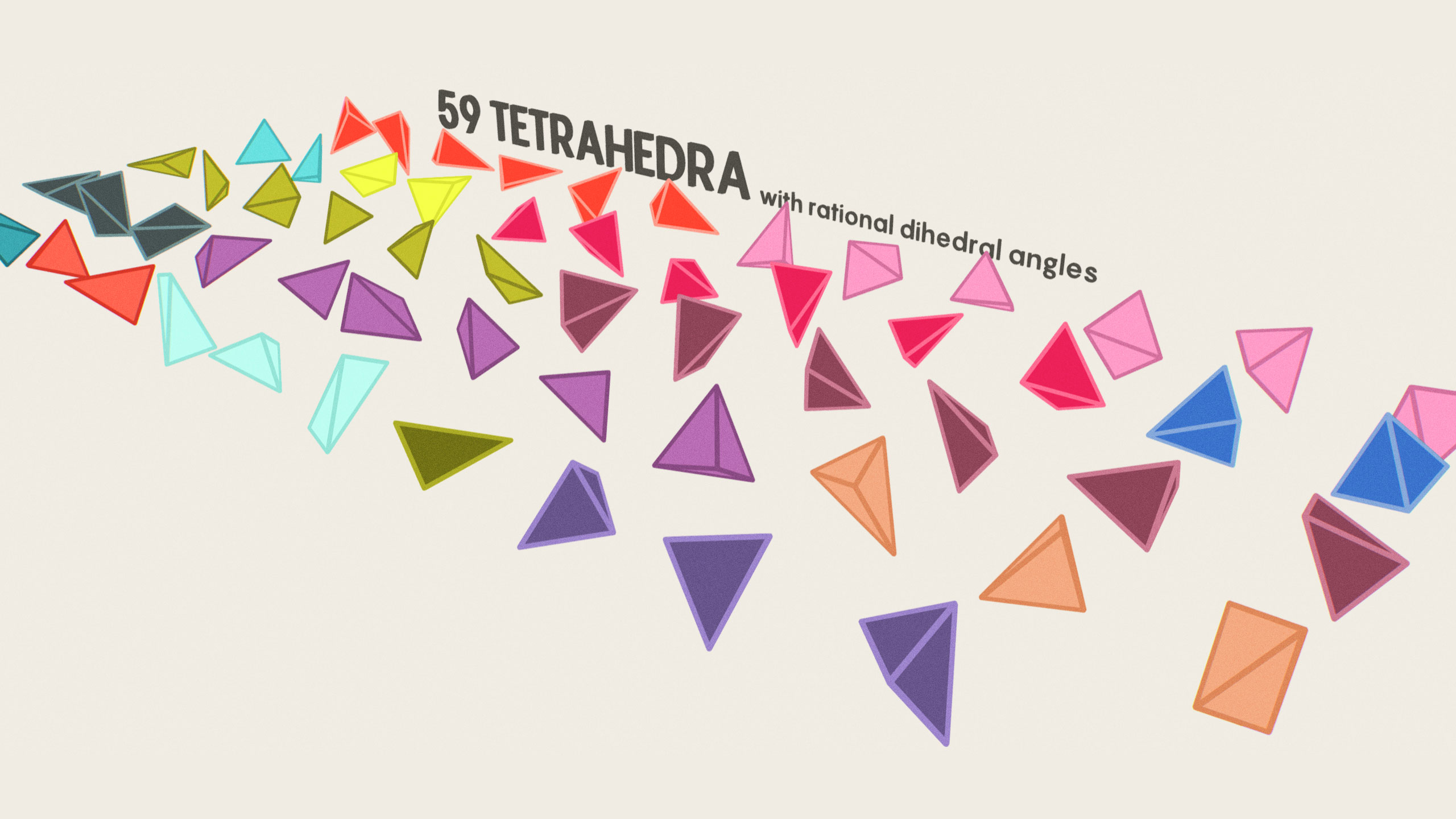Tetrahedron Solutions Finally Proved Decades After Computer Search
Introduction
The tetrahedron is the simplest three-dimensional shape with flat sides. Its basic properties have beguiled curious minds as far back as Plato and Aristotle. Now, a conclusive proof posted in November has certifiably identified all the special tetrahedra there are to find. The work answers a question about an ancient shape thanks to a cutting-edge innovation that provides mathematicians with a new technique for finding solutions to certain equations.
“These are idealized mathematical objects that are going to be with us forever, and now we know all of them,” said Martin Weissman of the University of California, Santa Cruz.
A tetrahedron has a triangular base and three triangular sides that form a pyramid. Pairs of faces meet along edges to create “dihedral” angles, of which a tetrahedron has six.
The new proof identifies all the different ways of configuring a tetrahedron so that all six dihedral angles have rational values, meaning each can be written neatly as a fraction. It establishes that there are exactly 59 isolated examples plus two infinite families of tetrahedra that meet this condition.
Mathematicians actually discovered these particular tetrahedra decades ago using computerized search techniques, but they didn’t know if there were any more. More broadly, they had no idea how to prove whether they’d found them all.
“They found those back in the 1990s, but it wasn’t until 2020 that we were able to prove they were the only ones,” said Kiran Kedlaya of the University of California San Diego. Kedlaya is a co-author of the proof, along with Alexander Kolpakov of the University of Neuchâtel in Switzerland, Bjorn Poonen of the Massachusetts Institute of Technology and Michael Rubinstein of the University of Waterloo. (Poonen receives funding from the Simons Foundation, which also funds this editorially independent publication.)
Samuel Velasco/Quanta Magazine
The problem of classifying tetrahedra with rational dihedral angles may appear simple, but solving it required years of accumulated mathematical knowledge, plus a degree of computing power that wasn’t readily available even a decade ago.
“This can’t be produced by someone just sitting around playing with pen and paper. They developed very sophisticated methods,” said Marjorie Senechal of Smith College.
The 30-page proof contains few drawings. Instead, its logic hinges on solving a polynomial equation, a type of equation that features coefficients and variables raised to powers, like y = 3x2 + 6. Of course, the polynomial at issue in the proof is much more complicated than that.
“Under the hood it’s a lot of number theory, but at its surface it’s geometry,” said Kedlaya.
The link between geometry and number theory gave the mathematicians an opening, but they had to work hard to exploit it. That’s because finding special solutions to complicated equations — and proving you’ve found them all — is inherently difficult. For most equations, mathematicians don’t know how to do it.
“There is no general method that will always be successful. You’ll almost always fail to answer the equation,” said Peter Sarnak of the Institute for Advanced Study.
Except in this case, the mathematicians didn’t fail. By discovering a new method for finding solutions to polynomial equations, they answered a basic question about shapes and possibly made it easier to find solutions to other equations in the future.
Testing Tetrahedra
The question of identifying all tetrahedra with rational dihedral angles — rational tetrahedra — was first formally stated in a 1976 paper by John Conway and Antonia J. Jones.
The two were motivated by a desire to find tetrahedra that could be cut up and reassembled as a cube of the same volume, a property known as scissors congruence. In exploring this problem, they were extending a line of thought that went back to 1900, when David Hilbert proposed 23 problems to guide mathematical inquiry in the 20th century. His third problem asked whether any pair of three-dimensional shapes with the same volume are scissors congruent. This was soon shown not to be true, but it turns out that all rational tetrahedra are congruent to the cube.
“Conway and Jones asked about rational tetrahedra as a special case of the much harder question of classifying tetrahedra,” said Kedlaya.
The pair got as far as sketching a method for finding these tetrahedra: solving a particular polynomial equation. Their equation features six variables, corresponding to a tetrahedron’s six dihedral angles, and it has 105 terms, reflecting the complicated way that dihedral angles of a tetrahedron relate to each other. (By contrast, you could think of the three interior angles of a triangle being related in terms of a simple polynomial with only three terms: a + b + c = 180 degrees.)
The polynomial equation Conway and Jones identified also has infinitely many solutions, representing the infinite configurations of possible tetrahedra. To find the desired ones, with all rational dihedral angles, Conway and Jones said that mathematicians needed to find a special class of solutions to the equation, which would correspond exactly to the rational tetrahedra.
They didn’t know how to find the solutions themselves, but they were confident that it could be done, writing, “It seems quite probable that the general tetrahedron … whose dihedral angles are rational can be found by our techniques.”
More than 40 years later, four mathematicians confirmed they were right.
Roots of Unity
Conway and Jones’ strategy is a fairly common one among mathematicians, who often look for special types of solutions when they study polynomial equations. These can be whole-number or rational-number solutions. Or, as is the case with this new work, they can be solutions that bear the elegant name “roots of unity.”
Most roots of unity do not appear on the ordinary number line. Instead, they are found among the complex numbers — numbers like 3 + 4i that have a real part (3) and an imaginary part (4). Roots of unity serve as solutions to polynomial equations and have the special algebraic property that raising them to a certain power gives 1. They also have a graceful geometric representation: They all lie on the unit circle in the complex plane.
To solve the Conway-Jones polynomial generally, mathematicians must assign complex numbers to all six variables so that the 105-term equation is true. The variables do not literally represent the angle measurements themselves, but instead stand in for complex numbers associated to the cosines of the angles. Conway and Jones observed that rational tetrahedra would correspond to solutions of the polynomial in which all variables are roots of unity.
“Your six angles become six points on the unit circle, and you need those complex numbers to satisfy a polynomial equation,” said Weissman.
Samuel Velasco/Quanta Magazine
Yet knowing this correspondence was less helpful than it might seem. Finding some solutions is one thing. Proving that you’ve found them all is an entirely different and much harder challenge.
In 1995, two of the authors of the new work, Poonen and Rubinstein, actually found what ultimately turned out to be every tetrahedron with rational dihedral angles. In essence they guessed their way to finding them, by plugging in combinations of six rational numbers.
“You can just try six rational numbers and plug them into the equation,” said Poonen. “The problem with that is that only lets you find solutions. It doesn’t let you know when you’ve found them all.”
Finding Every Solution
In their new work, the four mathematicians proved that the list of rational-angle tetrahedra Poonen and Rubinstein found 25 years ago was complete — there are no other examples waiting to be discovered.
Their collaboration began in March 2020, when Poonen attended a talk that mentioned some related work Kedlaya had done with another collaborator. The two had searched for the roots of unity of a different polynomial in order to settle a different classification question. Poonen immediately saw its relevance to his previous, unfinished inquiry into tetrahedra.
“Bjorn got super interested,” said Kedlaya. “He said, ‘Wait a minute, this is the thing I needed in the 1990s.’”
Poonen emailed Kedlaya and described the problem of finding rational tetrahedra. His brief email ended on an optimistic note. “I got pretty far with this back in the 1990s [with Michael Rubinstein], and I think with a lot of human and computer work it might be possible to finish it,” he wrote.
Following that email, Kedlaya reached out to Kolpakov, who was also using roots of unity to classify types of geometric shapes. At the same time, Poonen contacted his old collaborator Rubinstein. With the team in place, they set quickly to work.
“We pretty regularly would meet for maybe two hours each week for a few months,” said Kedlaya. And as they started their search for a comprehensive list of the roots of unity for the Conway-Jones polynomial, they had a very broad sense of where to look.
They knew that the solutions had to fall somewhere below some very large number, the upper bound. But the bound was so huge that there was no way to search every possibility below it.
“Those bounds in six variables are horrendous. They are far out of the reach of what’s feasible without fundamentally new ideas,” said Sarnak.
The four mathematicians made the hunt feasible through two main innovations.
First, they lowered the upper bound. In their new paper they proved that the single complicated polynomial equation representing the tetrahedra can itself be represented in terms of many simpler polynomials.
“We get from one six-variable equation to a collection of hundreds of simpler equations,” said Kedlaya.
They proved that the roots of unity of these simpler polynomials all lie below a much smaller upper bound than the vast and unsearchable one associated with the more complicated polynomial. And because of the correspondence between the simpler equations and the complicated one, finding roots of unity for one would lead to roots of unity for the other. Unfortunately, even the smaller interval was still too large for them to search without more to go on.
The authors’ second innovation was to devise a clever way of searching this smaller interval. They knew the solutions had a certain symmetric structure to them — which meant that if there was a solution on one part of the interval, there also had to be a solution on another part of the interval.
That allowed them to develop new algorithms that took advantage of this structure to search more efficiently. They also implemented these algorithms on far better computers than Conway and Jones had had at their disposal when they proposed the roots-of-unity attack on the problem.
“It turns out we had to upgrade [Conway and Jones’] strategy a bit, benefiting from 40 years of additional knowledge and better computers,” said Kedlaya.
The new algorithms searched every possible combination of solutions within the narrower interval. Based on this exhaustive final search, the authors finally proved that there are only 59 isolated examples of tetrahedra with rational dihedral angles, and two infinite families of tetrahedra — exactly the ones that Poonen and Rubinstein had happened upon decades earlier. The tetrahedra within each infinite family vary by a parameter, offering endless ways of increasing the size of some angles and decreasing others while keeping all dihedral angles rational.
The result has a little something for everyone.
For mathematicians interested in identifying the roots of unity of polynomial equations, the paper provides an advantageous new way of finding them. In particular, the methods the authors used to take the complicated Conway-Jones polynomial and reduce it to many simpler polynomials are likely to apply to other difficult polynomial equations that can’t be tackled directly.
“This work suggests there may be many other problems that seemed not feasible that may be feasible by these kinds of ideas,” said Sarnak.
And for mathematicians — and anyone else — who find pleasure in completeness, the paper provides a new and perfect answer: Here lie all the tetrahedra of your dreams.
“It is quite a beautiful achievement,” said Sarnak.




